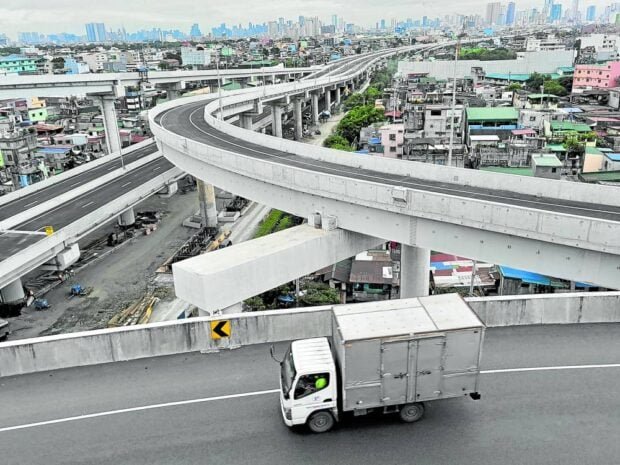400,000 Holy Week motorists seen to benefit from toll-free connector
BOCAUE, Bulacan, Philippines — Despite an anticipated increase in traffic volume with over 400,000 motorists headed for north or south Luzon during the Holy Week break, travel time is expected to be shorter with the recent opening of the first phase of the North Luzon Expressway (NLEx) Connector which remains toll-free.
In a statement, NLEX Corp. president and general manager Jose Luigi Bautista said they were estimating a 15 percent increase in the number of motorists passing through the expressway between Holy Thursday and Easter Sunday.
He said that from the regular daily average of 35,000 motorists using the NLEx-Subic Clark Tarlac Expressway (SCTEx), the figure was expected to go up to 402,500; from 160,000 to 184,000 for the Manila-Cavite Expressway (Cavitex); 16,000 to 18,400 for the Cavitex-C5 Link; and 34,000 to 39,000 for the Cavite Laguna Expressway (Calax).
To assist motorists, the tollway company will be fielding over 1,500 traffic and toll lane management personnel to the different expressways.
Avoid peak hours
The Metro Pacific Tollways Corp. (MPTC) which manages NLEx, Cavitex C5-Link, and Calax advised motorists to avoid traveling during peak hours and to use their Radio Frequency Identification (RFID) for faster toll payment.
“We are reminding our motorists to plan their trips and avoid the rush hours. The influx of travelers is anticipated starting in the afternoon of Holy Wednesday until the afternoon of Maundy Thursday, as well as in the afternoon to the evening of Black Saturday, Easter Sunday, and the Monday after Easter Sunday,” MPTC president Rodrigo Franco said. He also urged motorists to observe traffic discipline and practice safety.
The NLEX management said it would strictly enforce the 60-kilometer-per-hour speed limit for trucks, and the 80-kph speed limit for cars, sport utility vehicles, buses, and motorcycles using the NLEx Connector.
President Ferdinand Marcos Jr. inaugurated last week the 5-kilometer-long Caloocan-España section of the P23-billion NLEx Connector, which was designed to cut travel time between the two busy areas to about five minutes by easing traffic flow on España Boulevard, Abad Santos Avenue, Rizal Avenue, and Lacson Avenue.
The entire project is expected to be opened by June, once the right-of-way requirement for the remaining segment — España to Santa Mesa — is resolved.
Big boost
Cristina Tuzon, president of the Bulacan Chamber of Commerce and Industry, said the opening of the expressway would be a big boost to the economy of the province and the rest of Central Luzon.
“Computation of losses is based on every minute the goods and services are hampered from being delivered to their destinations. With this trip from Caloocan City to España Boulevard, which is the heart of Manila, we can save billions in our businesses and investments from the worse to worst traffic conditions in Metro Manila,” Tuzon told the Inquirer.
According to her, the positive impact of the NLEx Connector can be likened to the billions of pesos saved by economic players in Central and northern Luzon when the SCTEx, including the [Tarlac-Pangasinan-La Union Expressway] TPLEx opened years ago.
Tuzon said that from six hours, travel time to Baguio City was reduced by several hours.
“Not only goods and services are delayed in hours but even important meetings and appointments. This NLEx Connector will conserve our time,” she added.
When completed, the project would stretch 8 kilometers from Caloocan to near the Polytechnic University of the Philippines campus in Santa Mesa, Manila.
Enhanced police presence
It is expected to serve 35,000 vehicles daily and make access easier to ports in Manila and international airports like Ninoy Aquino International Airport and Clark International Airport.
The Philippine National Police, meanwhile, said on Sunday that it would deploy nearly 78,000 policemen to tighten security during the Holy Week and Ramadan celebrations.
A total of 38,387 policemen will be assigned to conduct mobile and beat patrols, while an additional 39,504 will be sent to specific areas of convergence such as major thoroughfares, transportation hubs, terminals, commercial areas, and places of worship, according to the data provided by the PNP Directorate for Operations.
The observance of Holy Week started on Palm Sunday, April 2, and would end on Easter Sunday, April 9. President Marcos earlier declared a five-day break from April 6 to 10 for Holy Week in addition to the Day of Valor or “Araw ng Kagitingan,” to create more long weekends pursuant to the “principle of holiday economics.”
The Muslim Holy Month of Ramadan, on the other hand, began on March 23 and would culminate with the celebration of Eid al-Fitr in the third week of April.
“The deployment of our police officers is aimed [at] provid[ing] maximum security coverage to the public who will take part in the various religious activities,” PNP chief Gen. Rodolfo Azurin Jr. said in a statement.
The National Capital Region Police Office will have the highest number of deployments, with almost 10,000 police officers, the PNP said.
Other regions with increased deployment include the Ilocos Region (covered by Police Regional Office 1) with 5,304 officers, Calabarzon (covered by PRO 4A) with 6,496 officers, and Bicol Region (covered by PRO 5) with 5,594 officers.
The Aviation Security Group will send 1,606 officers, while the Highway Patrol Group and Maritime Group will deploy 1,874 and 297 officers, respectively.

